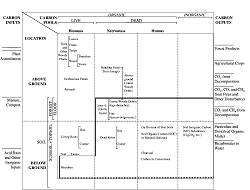2.2.5.3. Carbon Pools

|
Figure 2-3: Components of the terrestrial carbon pool (compiled
and amplified from Apps and Price, 1996).
|
To fully account for carbon at a site, one must examine the forest, the crops,
and the soils as a dynamic multi-component ecosystem, above- and below-ground,
with changes in biomass and soil organic matter as key tracking mechanisms.
The most easily measurable pool is the total standing aboveground biomass of
woody vegetation elements. The aboveground biomass comprises all woody stems,
branches, and leaves of living trees, creepers, climbers, and epiphytes, as
well as herbaceous undergrowth. In some inventories, dead fallen trees and other
coarse woody debris, as well as the litter layer, are included in biomass estimates;
in other inventories, these categories are considered as a separate dead organic
matter pool. In practice, standing timber volumes per hectare are often taken
as a proxy value, applying a locally tested conversion factor (see Section
2.4).
The below-ground biomass comprises living and dead roots, soil mesofauna, and
the microbial community. There also is a large pool of organic carbon in various
forms of soil humus (soil organic carbon, SOC). Other forms of soil carbon are
charcoal from fires and consolidated carbon in the form of iron-humus pans or
concretions. Many soils also contain a subpool of inorganic carbon in the form
of hard or soft calcium carbonate (soil inorganic carbon, SIC).
Another major pool of carbon consists of forest products (timber, pulp products,
non-timber forest products such as fruits and latex) and agricultural crops
(food, fiber, forage, biofuels) taken off the site. Section
2.4 discusses their measurement and the monitoring of their routing and
stability.
The components of the terrestrial carbon pools are illustrated in Figure
2-3.
|